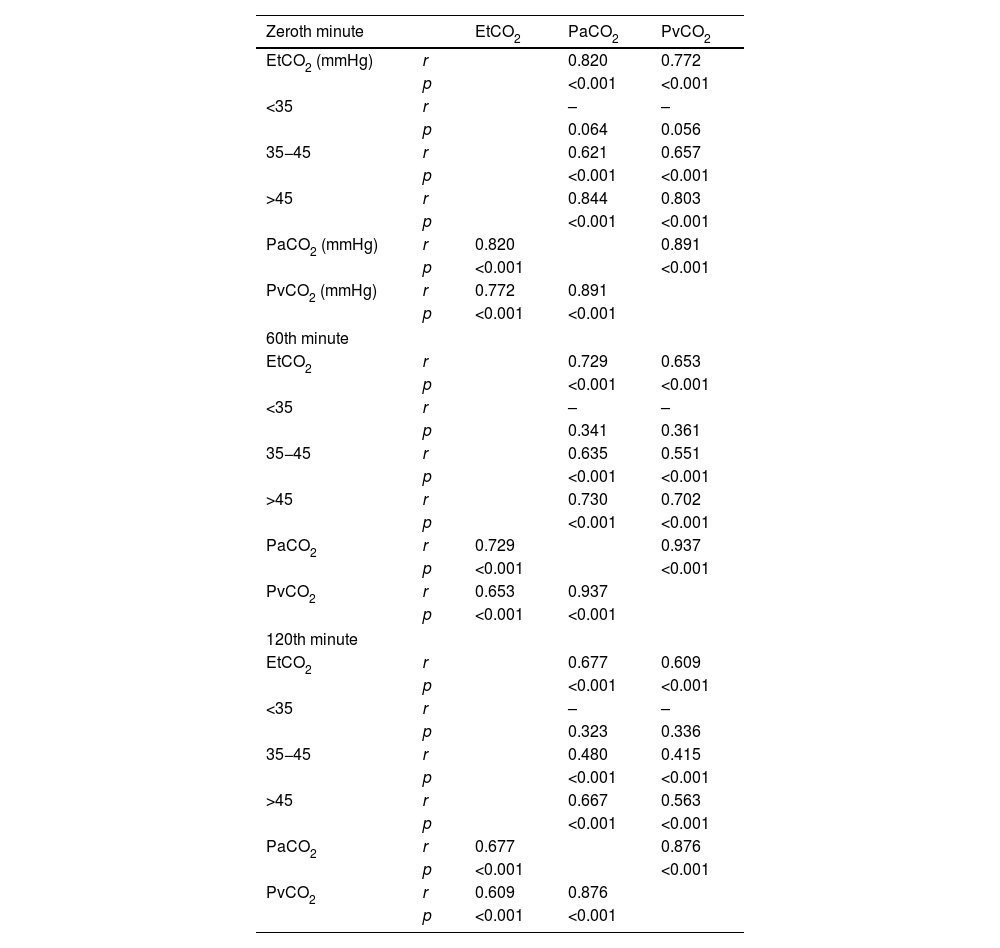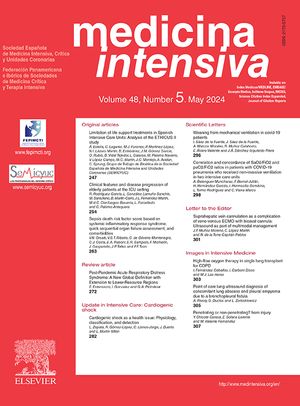To assess the feasibility of using end-tidal carbon dioxide (EtCO2) as a non-invasive substitute for partial pressure of arterial carbon dioxide (PaCO2) in emergency department (ED) triage and follow-up, and to explore the potential of partial pressure of venous carbon dioxide (PvCO2) as an alternative to PaCO2.
DesignProspective cross-sectional study.
SettingTertiary university hospital.
Patients or participants97 patients presenting with acute respiratory distress to the ED.
InterventionsEtCO2, arterial blood gases, and venous blood gases measured at admission (0 min), 60 min, and 120 min.
Main variables of interestCO2 levels.
ResultsAmong 97 patients (mean age: 70.93 ± 9.6 years; 60.8% male), EtCO2 > 45 mmHg at admission showed strong positive correlations with PaCO2 and PvCO2 (r = 0.844, r = 0.803; p < 0.001, respectively). Significant positive correlation was observed between 60-min EtCO2 and PaCO2 (r = 0.729; p < 0.001). Strong correlation between PaCO2 and PvCO2 at 120 min when EtCO2 > 45 mmHg (r = 0.870; p < 0.001). EtCO2 was higher in hospitalized patients compared to discharged ones.
ConclusionsEtCO2 appears promising as a substitute for PaCO2 in ED patients with acute respiratory distress within the initial two hours of treatment. Venous blood gas sampling offers a less invasive alternative to arterial sampling, facilitating simultaneous blood tests.
Evaluar la viabilidad de utilizar el dióxido de carbono al final de la espiración (EtCO2) como un sustituto no invasivo de la presión parcial de dióxido de carbono arterial (PaCO2) en el triaje y seguimiento en el departamento de emergencias (ED), y explorar el potencial de la presión parcial de dióxido de carbono venoso (PvCO2) como alternativa a PaCO2.
DiseñoEstudio prospectivo transversal.
ÁmbitoHospital universitario terciario.
Pacientes o participantes97 pacientes que se presentaron con dificultad respiratoria en el ED.
IntervencionesSe midieron EtCO2, gases en sangre arterial y gases en sangre venosa al ingreso (0 min), 60 min y 120 min.
Principales variables de interésNiveles de CO2.
ResultadosEntre 97 pacientes (edad media: 70,93 ± 9,6 años; 60,8% hombres), EtCO2 > 45 al ingreso mostró correlaciones positivas fuertes con PaCO2 y PvCO2 (r = 0,844, r = 0,803; p < 0,001, respectivamente). Se observó una correlación positiva significativa entre EtCO2 a los 60 min y PaCO2 (r = 0,729; p < 0,001). Fuerte correlación entre PaCO2 y PvCO2 a los 120 min cuando EtCO2 > 45 (r = 0,870; p < 0,001). EtCO2 fue mayor en los pacientes hospitalizados en comparación con los dados de alta.
ConclusionesEtCO2 parece prometedor como sustituto de PaCO2 en pacientes del ED con dificultad respiratoria dentro de las dos primeras horas de tratamiento. La toma de muestras de gases en sangre venosa ofrece una alternativa menos invasiva a la toma de muestras arterial, facilitando pruebas de sangre simultáneas.
Article
Go to the members area of the website of the SEMICYUC (www.semicyuc.org )and click the link to the magazine.












